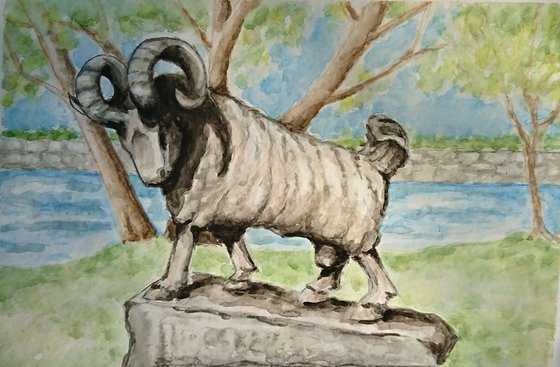- By medium
- By subject
- By budget
- Sales
- Gift cards
- Discover all art
- Artists
- Editors’ picks
- Ideas
Original artwork description:
A black ram was raised in the St Olaf's Castle in order to be eaten on a feast on the St Olaf's Day. There's also a legend of the black ram. According to it the ram repelled an enemy attack and thus saved the castle. It had climbed onto the castle wall, made noise with its hoofs and swung its great horns. Once the enemy saw it, they were sure it was the devil himself living in the castle. This frightened the enemy so much that it ran away. The last black ram of the castle fell off the castle wall and drowned in the stream in 1728, but legend still lives here…
Watercolor painting on paper. Original artwork. Unframed.
Certificate of Authenticity is included.
Tags:
#black #sculpture #animal #gift #original art #watercolor #legends #ram #svetlana vorobyeva #savonlinna #black ramBlack ram (2016) Watercolour
by Svetlana Vorobyeva
13 Artist Reviews
£83.87
- Watercolour on Paper
- One of a kind artwork
- Size: 39 x 26 x 1cm (unframed) / 39 x 26cm (actual image size)
- Signed on the front
- Style: Impressionistic
- Subject: Animals and birds
Loading
Original artwork description
A black ram was raised in the St Olaf's Castle in order to be eaten on a feast on the St Olaf's Day. There's also a legend of the black ram. According to it the ram repelled an enemy attack and thus saved the castle. It had climbed onto the castle wall, made noise with its hoofs and swung its great horns. Once the enemy saw it, they were sure it was the devil himself living in the castle. This frightened the enemy so much that it ran away. The last black ram of the castle fell off the castle wall and drowned in the stream in 1728, but legend still lives here…
Watercolor painting on paper. Original artwork. Unframed.
Certificate of Authenticity is included.
Tags:
#black #sculpture #animal #gift #original art #watercolor #legends #ram #svetlana vorobyeva #savonlinna #black ram14 day money back guaranteeLearn more



